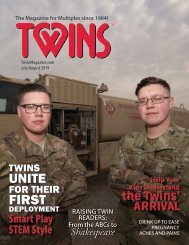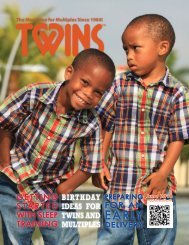2007GuideToTheFirstYear
Create successful ePaper yourself
Turn your PDF publications into a flip-book with our unique Google optimized e-Paper software.
NICU Primer<br />
When newborn multiples need medical intervention,<br />
they are generally transferred to the neonatal intensive<br />
care unit. A health-care team comprised of neonatologists,<br />
neonatal nurses, pediatricians, pediatric surgeons, pediatric<br />
resident physicians and neonatal respiratory therapists will<br />
be caring for your infants. Additional resources are provided<br />
by social services and pastoral counseling. Here are some issues<br />
parents encounter when infants require a stay in the NICU.<br />
Bonding. Physical and visual contact are very important in<br />
establishing a lasting attachment to your infants. When bonding<br />
is delayed, it can be “made up” through hands-on parenting in<br />
the NICU.<br />
Therapeutic handling. Proper handling of tiny babies can<br />
enhance and encourage relaxation, improve digestion, facilitate<br />
the development of head control and more. The staff will guide<br />
parents in proper techniques.<br />
Kangaroo care. This places the infant skin-to-skin with the<br />
parent. The baby sees, hears, smells and touches his parent while<br />
his temperature is monitored on a regular basis. Studies indicate<br />
this technique may lower infection rates and hasten discharge<br />
times.<br />
Nutrition. Feeding can be a complex challenge with high-risk<br />
infants. Depending on weight and condition, NICU infants may<br />
require intravenous, tube feedings (stomach or nasal) to provide<br />
sufficient caloric intake.<br />
Weight gain. Feedings, by any method, must begin as soon as<br />
possible. Babies are weighed daily, and more often, if they have<br />
fluid imbalances.<br />
Temperature control. A constant temperature is necessary<br />
for survival and is handled aggressively in the NICU.<br />
Oxygen therapy. When infants are on oxygen, they are monitored<br />
very closely, administered blood tests and may require<br />
continuous readings, including transcutaneous monitoring or<br />
pulse oximetry. These methods measure babies’ levels of oxygen<br />
saturation in the blood.<br />
Pain management. By 24 weeks’ gestation, the body processes<br />
that allow painful impulses to be transmitted are completed.<br />
Medication and non-pharmacological measures, such as comfort<br />
measures and positioning, can help manage pain.<br />
Monitors and machines. The electronic eyes of the NICU<br />
watch heart rate, blood pressure and breathing, as well as equipment<br />
function. Never to take the place of constant attention,<br />
monitors are necessary but should be viewed only as part of the<br />
landscape.<br />
Ultrasound. Ultrasound is a non-invasive, fast, painless diagnostic<br />
tool used to investigate clinical problems.<br />
Ventilators. The use of ventilators revolutionized the NICU.<br />
They provide oxygen and assistance with breathing or may actually<br />
breathe for the baby. A tube is placed in the baby’s nose or<br />
mouth, or through the trachea (windpipe).<br />
Co-bedding in the NICU<br />
—Cheryle G. Levitt, R.N., M.S.N.<br />
For twins, there is a natural attachment and only a sibling’s presence<br />
can provide substantial comfort and security. Co-bedding can<br />
offer incredible stress-reducing therapy in times of crisis. Some<br />
observed benefits to co-bedding include:<br />
• Better heart rate and lower oxygen requirements<br />
• Co-regulation of vital signs and body temperature<br />
• Improved physical growth and motor development<br />
• Shorter length of hospital stay<br />
• Decreased hospital readmissions<br />
• Enhanced parent-infant bonding<br />
• Easier transition to home<br />
More NICU articles<br />
TWINS Magazine publishes many stories on life in the NICU and preemie<br />
twins. Among them are:<br />
• “23-week twins Georgia state record,” by Clay Owens,<br />
Special Miracles, July/August 2004<br />
• “Easing the Pain of Tiny Patients,” by Sheree Geyer,<br />
March/April 2002<br />
• “The Emotional Toll of Preemies,” by Jennifer Reising, July/August<br />
2003<br />
To download copies of these and other stories, visit<br />
www.TwinsMagazine.com<br />
20 GUIDE TO THE FIRST YEAR © 2007 TWINS Magazine. To subscribe: call 1-888-55-TWINS or www.TwinsMagazine.com


















